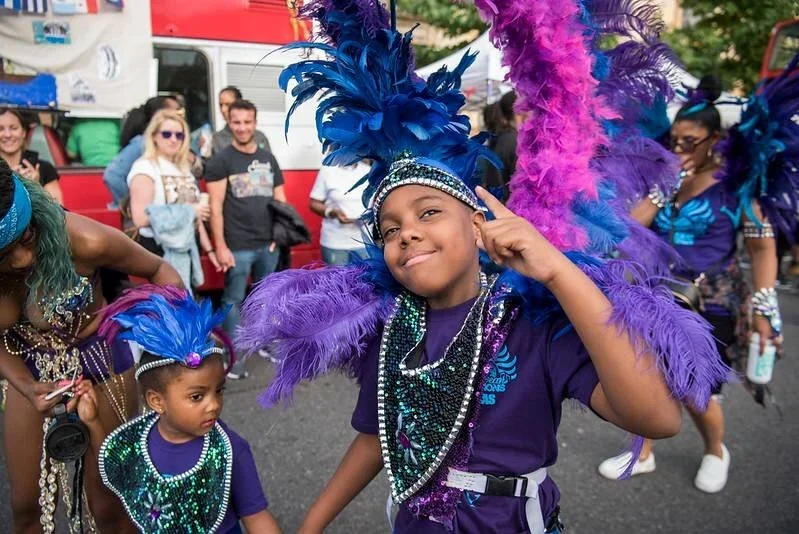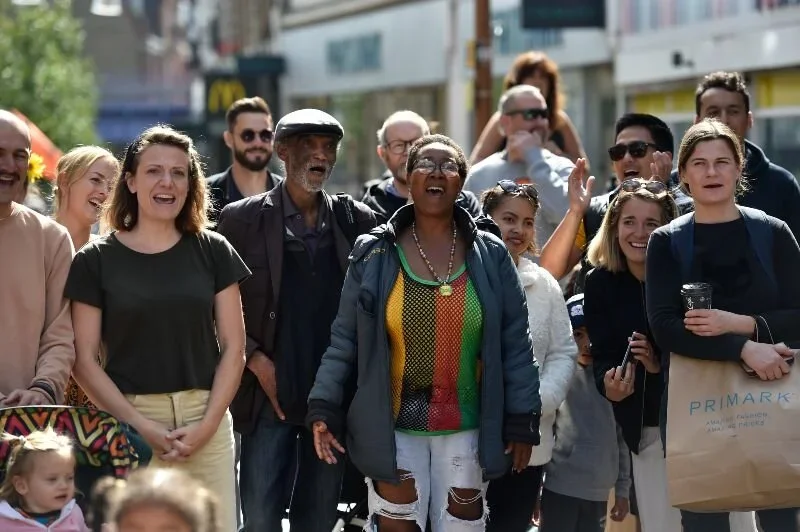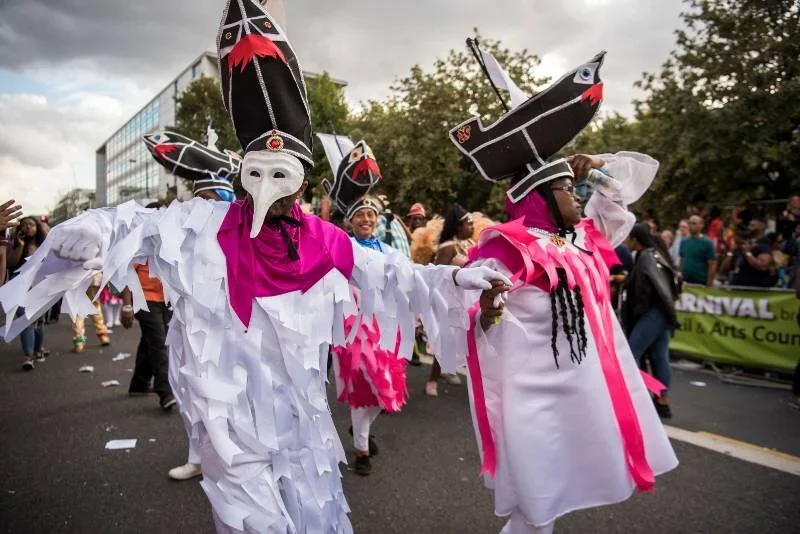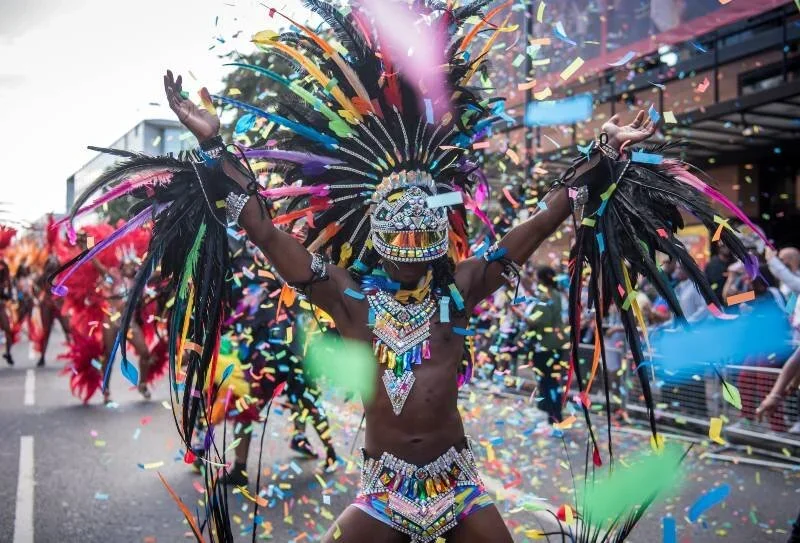The costumes of Hackney Carnival
A boy performing at Hackney Carnival
The Art of Masquerade
From handmade tie-dye tops to gloriously feathered headdresses, carnival has a wide variety of costumes representing cultures and countries from across the world. Playing Mas, or Masquerade, is the term used to describe wearing costumes and dancing along the street with a carnival band or group. Mas, as the ‘theatre of the streets’ is the visual backbone and unifying force of Carnival.
Carnival costume making is a year-round activity, which involves the development of themes and the communication of stories through movement and fabric. These aspects of the masquerade band operation include the skills required to manage a mas camp where carnival artists and their followers create costumes, some of which are elaborate feats of engineering.
Many people purchase their costumes or branded T shirts from the carnival band so that they can identify with them as they move along the street.
An audience on the Narrow Way watch carnival drumming
Traditional Mas
The history of the masquerade is rooted in African culture and the history of enslavement in the Caribbean islands where white settlers held elaborate masquerade balls before the Lenten season began.
The slaves, who could not take part in the celebrations, would observe them, often through windows, and decided to hold celebrations of their own. The celebrations would include dancing, singing, costumes and mockery of the people who held the masquerade balls.
Characters that mimicked the slavers were invented and these still endure in Caribbean carnival and inspire some of the designs at Hackney Carnival each year. Rena Kydd Williams (R Consultancy and Soca Saga Boys) explains:
Soca Saga Boys has a continual theme titled a “Traditional Mas” in Hackney carnival. The origins of our themes pre date traditional Trinidad Carnival characters. Our themes encompass the original underpinning of an enslaved age where our ancestors were given a labour free day from the plantation to be themselves.
The characters they used as well as the use of amplified sound was key in order to send vital messages of liberation planning, the comforting of barbaric treatment and maintaining connection with spirituality as opposed to the imposed religion of Christianity. Our themes of traditional African characters are also merged with current more modern spectacles of mas, which now promote a more liberal narrative of Afro Caribbean culture.
Each year we draw upon an Afrocentric carnival character from different Caribbean islands and over the last two years we have incorporated the more recent struggles of the Windrush generation through visual mas representation – something which is crucial to the make up of the Hackney population.
A woman shows off her face paint - a colourful image of Africa on her face
African Masquerades
The direct connection with African culture can also be seen at Hackney Carnival through the various West African troupes that appear in the parade, including Gahu Dramatic Arts, Blema Dancers and Yaram Arts. Malik Jeng from Yaram Arts describes Medieval Masquerades that can be traced back to West Africa at the height of its civilisation:
The masquerades are dressed in a cow hair mask, black and yellow paint on their faces and a costume composed of different animal furs, fabrics and shells. We present the 'Huntin' masquerade from the Yoruba people (SW Nigeria) and Creole/Krio people (Sierra Leonne & The Gambia). Then the 'Kankourang' masquerade from the Mandinka people (The Gambia, Southern Mali, Eastern Guinea and Northern Ivory Coast). At Hackney Carnival Zimba has become increasingly popular. The Zimba (Lion) Masquerade is from Mauritania, Gambia, Mauritania and Senegal. It is much loved at Hackney carnival. Zimbas evoke fear and laughter in their audiences with their highly physical, ferocious performances and sometimes with fire breathing. Drums are also part of this ritual and are used to tame the lion dancer by invoking spirits.
In these times, the dance and drumming are more of a celebration but in the past it meant identity, rites of passage, spirituality and protection.
Fancy Sailors are traditional Caribbean carnival characters
Fancy Sailors
The Fancy Sailor is another traditional character from Caribbean Carnival, brought to Hackney Carnival each year by Soca Massive. Michael Olton tells us about how this has evolved over the years:
Soca Massive was mainly a music-based group with DJs and sound systems appearing on the road and at festivals since the 1980s. We started bringing out a costume band in 2006 and in 2008 the fancy sailors appeared.
The Sailor Mas was introduced in the 1880s when British, French and American naval ships came to Trinidad. The costume typically consists of a headdress, sometimes made through a wire bending technique, a walking stick and bell-bottomed pants. There are different types of Fancy Sailors, each with a variation of the costume and dances to go with them. Olton continues —
Our Fancy Sailors have evolved over the years and have a modern twist so that it appeals to a younger generation. Our designer and wire-bending expert, Sean Carrington, researches different historical themes and then uses some of the Fancy Sailor style like the bell-bottoms to design more glamorous bikini based costumes such as the Might of Rome with a troupe of centurions or Pirates with fancy hats and cutlasses. However, the more mature people in the band don’t like the bikinis and bras. They want to wear a costume that doesn’t expose them too much. Carnival is about portraying a character rather than a bikini and feathers that all look the same.
A Hackney Carnival performer
Themes
Each year the participating groups devise their own well researched themes that inform the costume design, music and dance. Themes can be political, historical or just plain fun! In 2019 Carnival Band of the Year, Tropical Isles, were inspired by the Black Panther superhero film. In the past they have presented a wide range of themes entitled Eden, I Have a Dream, 5th Element, It’s a London Thing. Marva Antoine, Managing Director, describes the way they choose their themes:
We run workshops at our space for young people to devise the theme. They all do the research, so it’s a collective process. The costume style has changed over time and as the young people mature they want to look glamorous in the bikini style but some of them don’t want to feel so exposed so we find ways of adapting the costumes. Bikini and shorts based costumes are more affordable and the larger scale Kings and Queens costumes are very costly. So Tropical Isles does one main large scale costume and some smaller ones representing a theme and often trying out new technologies. Paul McLaren of Shademakers is our favourite designer. Paul was the first person to show Tropical Isles how to make engineered 3D backpack costumes.
Jamboulay Carnival Arts Promotion specialise in traditional African / Caribbean costumes by researching for themes to reflect on any issues past or current. Founder Rubena Waldrop says:
More recently the young people are requesting a touch of feathers, bikinis and beads. However, we strive to keep the traditional aspect of the arts while attempting to incorporate some modern styles. We have core designers including myself but generally it is a community effort using volunteer skills and expertise from within the local community. I am the last person to fuss about what to wear when carnival time comes. The members often ask, ‘What are you wearing?’ As the band leader I have to encourage and stimulate the atmosphere so I will grab something, slap some make-up on and join in the fun!
Zimba Yaram Arts performer
Design
Creating costumes appropriate for the band is an important focus for Paracarnival’s founders Richard Selim Sleeman and Bettina Fernandez Sleeman. Richard aims to work to Brazilian Rio Carnival standards, learned from his time spent with the renowned Paraiso band.
As an inclusive carnival band Paracarnival has developed a range of costumes for wheelchair users, “In 2015, we made a huge crinoline style Baina dress that we fixed over the wheelchair. This required making it lightweight enough so that it wouldn’t unbalance the wearer. We also work with people from Muslim backgrounds so we are careful to design costumes that are modest.” In 2019 Paracarnival won best theme interpretation for their focus on the environment and Save the Amazon Rainforest theme.
As best movement band at Hackney Carnival 2019 Dimensions’ designer, Churlene Greene is aware that the costumes need to work for highly choreographed routines, “so they have to be light and robust enough to survive plenty of movement. The costumes start off as a blend of comfortable stretch dancewear and carnival accessories.”
Lucky Thomas, Pan Vibrations, observes that Brazilian Rio style costume design has changed the look of Hackney Carnival:
There are bands still bringing old mas characters, but they’ve had to conform and try to appeal to younger people. Costumes are in danger of looking the same. It’s more inspiring and challenging when you have a story and a theme such as historical or current events. Trinidadian designers from the past like Wayne Berkeley and Peter Minshall have amazed me with their ideas. Also there are less mas camps in Hackney now. It would help to pass on skills if there was a carnival resource centre where carnival arts could be supported. Skills like wire bending are being passed on but new techniques are also being developed. The person I learned the most from was Lincoln Rahamut (RIP).
Rena Kydd Williams also acknowledges Lincoln’s influence and his use of fibreglass rod and wire. She says: “You need a mathematical, engineering based mindset to make those large scale structures.”
Lincoln Rahamut (1946—2019) originally from Perpetual Beauty Carnival Arts, based in Hackney at one time, and then leader of Masquerade 2000 was a strong influence on costume design for numerous carnival bands and he was commissioned to run master classes with Hackney groups. In his opinion, “Carnival is living art. We use all sorts of creative arts within Carnival. We do sculpture and cover all aspects of history, life and emotion. We research and create all these costumes to reflect something.”
Materials
When it comes to materials most carnival groups agree with Marva Antoine, “Without feathers there are no carnival costumes.” However, many designers succeed in creating extravagant and original designs with few resources demonstrating innovation and resourcefulness.
I like materials that have flow and use a lot of fabrics. There was a time, when I was studying HND in fashion design and management that I started looking at holographic materials using them to make 3D shapes by folding. I like to work with a bit of everything including recycled plastics, scrap metal as well as more natural materials. — Lucky Thomas
Taru Arts have devised ways of making carnival hats from juice cartons, crisp packets (with the silver side showing) and newspaper that can be adapted for different themes and decorative shapes.
I feel a necessity to make: it’s what I love and need to do it. My inspiration comes from the materials available and I respond to them intuitively. Improvisation and experimentation are important when using waste materials. It’s a challenge as it brings with it a responsibility not to end up with everything in the landfill. We need to ensure that we use materials that go together, like for like, and that they can last the course of the carnival parade but also be returned to recycling. This way of working is affordable in terms of materials costs but takes more labour and design time as well as cleaning to ensure the materials are safe. — Valerio Oliveira
Rena Kydd Williams reflects:
The underlying history of carnival was always about being sustainable. What has changed is capitalism and survival. We are required to meet the WOW factor. This comes at a commercial price and we are competing with people who spend more money each year. It’s hard to use old traditions that have been over taken by mass production. We recycle as much as we can but people who have bought a costume want something of high quality. Customers want glamour and a certain look. Consumerism and capitalism has undermined the original way of doing carnival.






